Lands unsuited for food crops represent huge untapped resource to grow mixed species biomass for ethanol.-
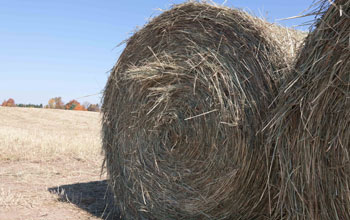
Bales of cellulosic biomass: Marginal lands may be a prime source for alternative energy.
Credit: Phil Robertson, MSU
Download the high-resolution JPG version of the image. (1.2 MB)
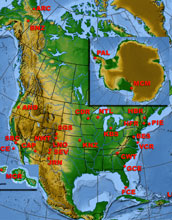
NSF's Long-Term Ecological Research Network comprises 26 land, coastal and ocean sites.
Credit: NSF LTER Network
Download the high-resolution JPG version of the image. (2.5 MB)
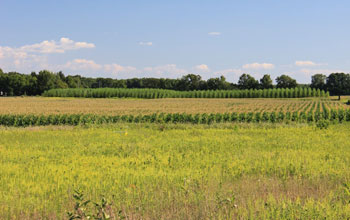
NSF KBS LTER site experimental plots: Corn and hybrid poplar are in the background.
Credit: Julie Doll, MSU
Download the high-resolution JPG version of the image. (348 KB)
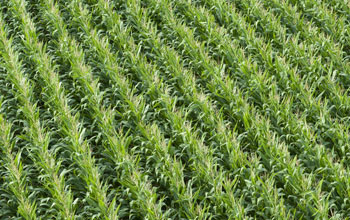
Corn at the KBS LTER site: Corn currently dominates biofuel production in the U.S.
Credit: K. Stepnitz, MSU
Download the high-resolution JPG version of the image. (306 KB)
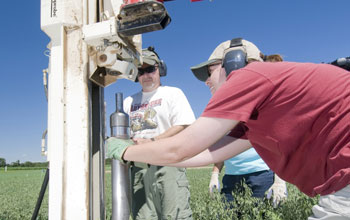
Researchers collect soil cores to determine carbon storage at the LTER site.
Credit: K. Stepnitz, MSU
Download the high-resolution JPG version of the image. (317 KB)
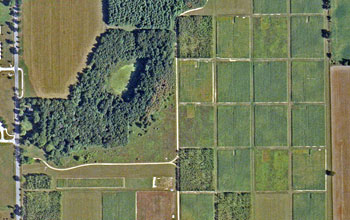
Satellite view of the cropping systems experiment: Each rectangle is 2.5 acres.
Credit: SPOT Image
Download the high-resolution JPG version of the image. (382 KB)
Marginal lands--those unsuited for food crops--can serve as prime
real estate for meeting the nation's alternative energy production
goals.
In the current issue of the journal Nature,
scientists at Michigan State University (MSU) and other institutions
show that marginal lands are a huge untapped resource for growing
mixed-species cellulosic biomass.
These lands could annually produce up to 5.5 billion gallons of ethanol in the Midwest alone.
Cellulosic ethanol is a biofuel produced from wood, grasses or the inedible parts of plants.
"Understanding
the environmental impact of widespread biofuel production is a major
unanswered question in the U.S. and worldwide," said Ilya Gelfand, lead
author of the paper.
"We estimate that using marginal lands for
growing cellulosic biomass crops could provide up to 215 gallons of
ethanol per acre with substantial greenhouse gas mitigation."
The notion of making better use of marginal lands has been around for nearly 15 years.
However,
this is the first study to provide an estimate for greenhouse gas
benefits, and an assessment of the total potential of these lands to
produce significant amounts of biomass, Gelfand said.
Focusing on
10 midwestern states, researchers from MSU, the Pacific Northwest
National Laboratory and the University of Maryland used 20 years of data
from the National Science Foundation (NSF) Kellogg Biological Station
(KBS) Long-Term Ecological Research (LTER) site.
Kellogg
Biological Station is one of 26 such NSF LTER sites in ecosystems around
the world from grasslands to deserts, coral reefs to tundra.
"The
study underscores the critical role that long-term basic research plays
in determining the optimum balance between economic prosperity and
environmental sustainability," said Saran Twombly, program director in
NSF's Division of Environmental Biology.
"Long-term basic
experiments suggest that wise management of marginal lands, rather than
wholesale conversion of valuable agricultural lands, could contribute
significantly to a sustainable future," Twombly said.
The
scientists characterized the comparative productivity and greenhouse gas
impacts of different crops, including corn, poplar, alfalfa and
old-field vegetation.
They then used a supercomputer to identify
and model biomass production that could grow enough feedstock to support
a local biorefinery with a capacity of at least 24 million gallons per
year.
The final tally of 5.5 billion gallons of ethanol represents
about 25 percent of Congress' 2022 cellulosic biofuels target, said
Phil Robertson, co-author of the paper and director of the KBS LTER
site.
"The value of marginal lands for energy production has been long-speculated and often discounted," he said.
"This
research shows that these lands could make a major contribution to
transportation energy needs, while providing substantial climate and--if
managed properly--conservation benefits."
This is also the first
study to demonstrate that grasses and other non-woody plants that grow
naturally on unmanaged lands are sufficiently productive to make ethanol
production worthwhile, he said.
Conservative numbers were used in
the study, the scientists said, and production efficiency could be
increased by carefully selecting the mix of plant species.
Additional benefits of using marginal lands include:
- New revenue for farmers and other land owners;
- No food-vs.-fuel conflict, as food production would not be displaced by fuel production;
- No indirect land-use effects, where land in another part of the globe is cleared to replace land lost to food production; and
- No carbon debt from land conversion, if existing vegetation is used or if new perennial crops are planted directly in existing vegetation.
The research was also funded by the Great Lakes Bioenergy Research Center and MSU AgBioResearch.
-NSF-
Media Contacts
Cheryl Dybas, NSF (703) 292-7734 cdybas@nsf.gov
Layne Cameron, MSU (765) 748-4827 layne.cameron@cabs.msu.edu
Layne Cameron, MSU (765) 748-4827 layne.cameron@cabs.msu.edu
Related WebsitesNSF Long-Term Ecological Research Network: http://www.lternet.edu
NSF Kellogg Biological Station LTER Site: http://www.lternet.edu/sites/kbs
NSF News Release: Scientists Develop New Carbon Accounting Method to Reduce Farmers' Use of Nitrogen Fertilizer: http://www.nsf.gov/news/news_summ.jsp?cntn_id=123848
NSF LTER Discovery Articles Series: http://www.nsf.gov/discoveries/disc_summ.jsp?cntn_id=125511&org=NSF
NSF Kellogg Biological Station LTER Site: http://www.lternet.edu/sites/kbs
NSF News Release: Scientists Develop New Carbon Accounting Method to Reduce Farmers' Use of Nitrogen Fertilizer: http://www.nsf.gov/news/news_summ.jsp?cntn_id=123848
NSF LTER Discovery Articles Series: http://www.nsf.gov/discoveries/disc_summ.jsp?cntn_id=125511&org=NSF
The National Science Foundation (NSF) is an independent federal
agency that supports fundamental research and education across all
fields of science and engineering. In fiscal year (FY) 2012, its budget
is $7.0 billion. NSF funds reach all 50 states through grants to nearly
2,000 colleges, universities and other institutions. Each year, NSF
receives over 50,000 competitive requests for funding, and makes about
11,000 new funding awards. NSF also awards nearly $420 million in
professional and service contracts yearly.
Useful NSF Web Sites:
NSF Home Page: http://www.nsf.gov
NSF News: http://www.nsf.gov/news/
For the News Media: http://www.nsf.gov/news/newsroom.jsp
Science and Engineering Statistics: http://www.nsf.gov/statistics/
Awards Searches: http://www.nsf.gov/awardsearch/
NSF Home Page: http://www.nsf.gov
NSF News: http://www.nsf.gov/news/
For the News Media: http://www.nsf.gov/news/newsroom.jsp
Science and Engineering Statistics: http://www.nsf.gov/statistics/
Awards Searches: http://www.nsf.gov/awardsearch/
The National Science Foundation (NSF) .-
Guillermo Gonzalo Sánchez Achutegui
ayabaca@gmail.com
ayabaca@hotmail.com
ayabaca@yahoo.com
Inscríbete en el Foro del blog y participa : A Vuelo De Un Quinde - El Foro!

No hay comentarios:
Publicar un comentario